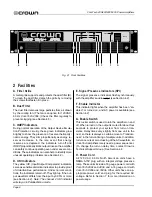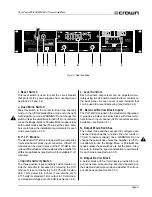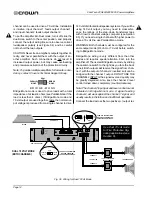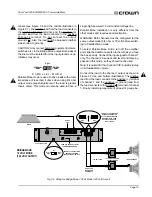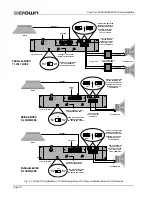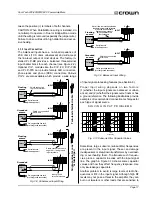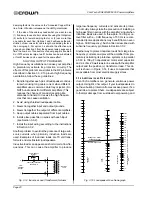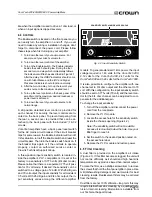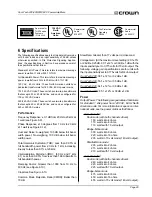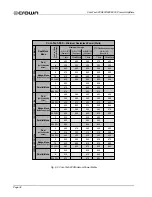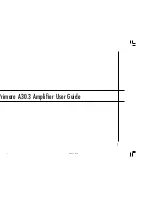
Page 22
Com-Tech 200/400/800/1600 Power Amplifiers
4 Operation
4.1 Precautions
Although your amplifier is protected from internal and
external faults, you should still take the following pre-
cautions for optimum performance and safety:
1. Improper wiring for the Dual, Bridge-Mono and
Parallel-Mono modes, as well as the 8/4 ohm and
70 volt output modes can result in serious operating
difficulties. Refer to Section 3.3.1 for details.
2. WARNING: Never attempt to operate the amplifier in
either Bridge-Mono or Parallel-Mono mode unless
both output channels are configured the same (8/4
ohm or 70 volt).
3. When driving an inductive load (like a 70 volt step-
down transformer) use a high-pass filter or protec-
tive network to prevent premature activation of the
amplifier’s protection circuitry (see Section 3.3.3).
4. WARNING: Do not change the position of the dual/
mono switch or the output mode switches unless the
amplifier is first turned off.
5. CAUTION: In Parallel-Mono mode, a jumper must
be installed between the channel 1 and 2 positive (+)
output terminals. Be sure to remove this jumper for
Dual or Bridge-Mono modes, otherwise high distor-
tion and excessive heating will occur.
Check the
dual/mono switch on the back panel for proper
position.
6. Turn off the amplifier and unplug it from the AC mains
before removing a
P.I.P. card or before removing the
dust filter.
7. Use care when making connections, selecting sig-
nal sources and controlling the output level. The
load you save may be your own!
8. Do not short the ground lead of an output cable to
the input signal ground. This may form a ground
loop and cause oscillations.
9. Operate the amplifier from AC mains of not more
than 10% above or below the selected line voltage
and only the specified line frequency.
10. Never connect the output to a power supply output,
battery or power main.
Such connections may result
in electrical shock.
11. Tampering with the circuitry by unqualified person-
nel, or making unauthorized circuit changes may be
hazardous and invalidates all agency listings.
Remember: Crown is not liable for damage that results
from overdriving other system components.
4.2 Indicators
The front panel of a
Com-Tech amplifier has several
helpful indicators. The amber
Enable indicator
is pro-
vided to show the amplifier has been turned on (or en-
abled) and that its low-voltage power supply is
working. It does not indicate the status of the high-volt-
age power supplies. For example, the Enable indicator
will remain lit in the unlikely event that one of the
amplifier’s protection systems (described in Sec-
tion 4.3) removes power from one (or both) high-volt-
age supplies to put the channel in “standby” mode.
The Enable indicator will be illuminated for all condi-
tions shown in Figure 4.1 except for the first example,
“There is no power to the amplifier.”
The green
ODEP indicators
confirm the normal opera-
tion of Crown’s patented Output Device Emulation Pro-
tection circuitry. During normal operation, they glow
brightly to confirm the presence of reserve thermal-dy-
namic energy. They dim proportionally as the energy
reserve decreases. In the rare event that there is no
reserve, the indicators will turn off and
ODEP will pro-
portionally limit the drive level of the output stages so
the amplifier can continue safe operation even when
conditions are severe. (For a more detailed description
of
ODEP, see Section 4.3.1.)
A channel’s
ODEP indicator also turns off if its high-
voltage power supply is put in “standby” mode or the
amplifier’s circuit breaker is tripped. The standby
mode is activated if DC or heavy common-mode cur-
rent is detected at the output, if the transformer thermal
protection system is activated, or if a
P.I.P. like the
P.I.P.-UL1711 or the IQ-P.I.P. is used to shut down a
high-voltage power supply. (For more information, see
Section 4.3.3 and the table in Figure 4.1.)
The yellow
IOC indicators
act as sensitive distortion
meters to provide
proof of distortion-free performance.
The
IOC (Input/Output Comparator) circuitry com-
pares the incoming signal’s waveform to that of the
output. Any difference between the two is distortion.
The
IOC indicators flash if there is a difference of
0.05% or more. It is normal for them to light momen-
tarily when the amplifier is first turned on.
Note: the
channel 2 IOC indicator will stay on in Parallel-Mono
mode.
The green
Signal Presence Indicators
(SPI) flash syn-
chronously with the output audio. The SPI detector cir-
cuit is connected in the signal path after the input gain
stages and level controls, so a flashing indicator tells
you that there is audio in and out of the amplifier.
Note:
The Signal Presence Indicators may not report signal
presence if the output signal level is too low.

